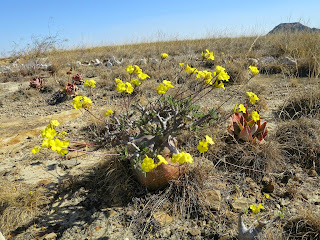
















Leaving Ambositra was quite a challenge. We had to wait for over 3 hours for a taxi bus heading towards Fianarantsoa, the nearest city and the second largest city in Madagascar. When a taxi bus finally arrived, there were many more people who wanted to take it than there were seats on the bus. Thankfully, the bus operator knew we had been waiting almost longer than anyone else, and he made sure we got two seats - in the very back, without a window, sharing the row with two other full-grown men. There was maybe enough leg room for a small child - we all angled our legs the same way to try to get them to fit. All together, there were maybe 30 people in this little bus. And the engine was in pretty bad shape - when we went up hills, of which there are many in this part of Madagascar, we could barely make it. Sometimes we were racing guys on bicycles to the top. I think we usually won, but just barely. The fumes in the back were also pretty bad. And to top it all off, after 4+ hours of this, close to Fianarantsoa, we saw a similar bus flipped over that had gone over an embarkment.
Needless to say, we were pretty exhausted when we got into town, just before dark. We found a really nice hotel, and were looking forward to a relaxing evening. Well, soon after my hot shower, I started to develop a strange rash - after some googling and a quick email to my sister, we decided it was hives, an allergic reaction, most likely to something (or someone) on the bus. It was probably a reaction to an animal - these buses often transport chickens, goats, ducks, anything small enough to bring on board or attach to the roof. Not to mention all the animals our fellow passengers had contact with before the trip - zebu, dogs, cats, probably mice, rats, bats, who knows. Anyway, my arms and legs were covered in hives for 2 days and my feet and hands swelled. Thankfully my wonderful husband got me some antihistamines which actually worked very well in managing the symptoms. Needless to say, we have made a blood oath to each other never to take another taxi bus as long as we live.
Caryl went out the next morning and hired us a driver and a 4 wheel drive vehicle to take us the rest of the way to Isalo. Because the roads are so bad and driving conditions are so crazy, you cannot rent a car without a driver. With gas and tip it cost about $100 a day - much more than the $4 per person on a bus, but priceless for us. Patrick, our driver, was lovely and professional. He told us his wife is pregnant with his first baby - I hope they have a wonderful family. I wish them 7 boys and 7 girls - the proper Malagas blessing. Anything to keep me out of taxi buses.
After leaving F-town, as we called Fianarantsoa (pronounced Fianarantsu), we stopped for a little while in Ambalavao, and again in Ihosy for snacks and a beer. We arrived in Ranohira (means lemur song), the town just outside of Isalo, in just a few hours, feeling pretty good. We found a hotel and went to the park office to arrange a guide for the next morning.























































